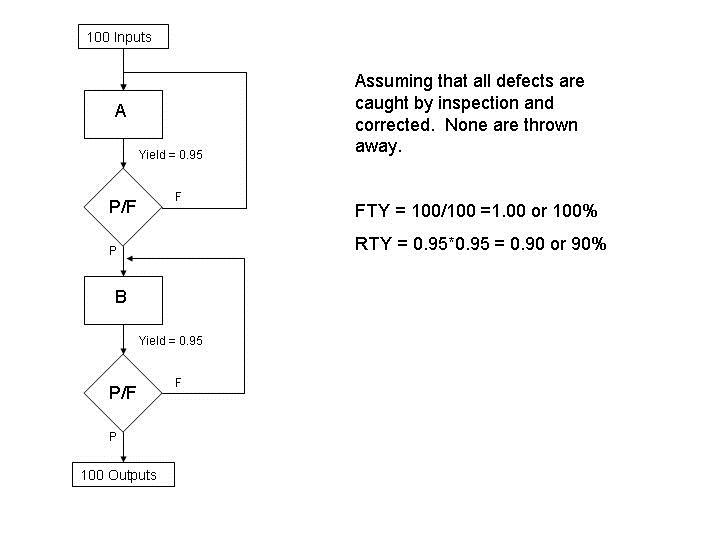Calculating Process Yield by Walter McIntyre
I recently visited several contract manufacturers (CM) to discuss a project I am working on. The purpose of the visits was to evaluate their ability to produce an electronic device we are developing for the automotive industry. One of the production control metrics I asked from each project manager was an estimate of the typical roll throughput yield on their production lines.
Only one of the project managers knew the rolled throughput yield (RTY) on their lines. All the others gave me a first time yield (FTY) instead. When I pressed each of these about how they manage quality on their production lines, they gave me their version of how failed units are repaired or disposed of before shipping, so that our customers are protected. This approach makes the yield look better than it really is and increases the CM’s cost of production. Make no mistake, increased cost for the CM means increase cost to you, the customer.
The one CM who knew his production line’s rolled throughput yield, also gave me dollar amounts of lost value through wasted components and rework. This CM also addresses the yield issues at each step in their production process with improvement teams.
A significant difference in the quotes received for the CM’s we visited was their circuit board testing schedule. Rather than test every circuit board in the production stream, as the first time yield CM’s did, the CM using roll throughput yield was able to reduce this to 10 percent of every production run. This is a direct result of having good control of their production process. The result was the roll throughput yield CM giving us the lowest quoted cost of production.
This experience led me to write this piece on the various ways to calculate the yield from a process. If you are a CM, I encourage you to use roll throughput yield and make yourself a hero of cost reduction in your business. If you are evaluating CM’s for a project, make sure you look hard at the way they calculate yield on their production lines and how they use the results.
First Time Yield (FTY): The probability of a defect free output from a process is called the First Time Yield. This metric considers only the criteria at the end of the process. The first time yield is unit sensitive and is calculated by dividing the outputs from a process by its inputs.
The First Time Yield will not detect the effect of hidden factories. Consequently, it will typically indicate that a process is performing better than it really is. Even so, this is the most common way to calculate process yield in business today. This is due, in part, to the way businesses report their performance to financial analysts. It is useful to the business in this way, but First Time Yield will not help the business find and correct problems in their processes.
Rolled Throughput Yield (RTY): Rolled Throughput Yield is the probability of passing all “in-process” criteria for each step in a process, as well as all end process criteria. Rolled Throughput Yield is defect sensitive. Mathematically, Rolled Throughput Yield is the result of multiplying the First Time Yield’s from each process step together.
When a process step produces defects, the yield for that step will be less than 100%. Even if the defective outputs are corrected (a separate process step), the yield for this step is unchanged. The drawing below shows the relationship between First Time Yield and Rolled Throughput Yield.

Yield
In the example above, the First Time Yield indicates a good process with no defects getting to the customers. There are 100 inputs and 100 outputs. The First Time Yield does not capture the effect of the 5 % defect rate from each of the process steps. Ten percent of the outputs are being reworked to keep customers from getting defects. The process has to do enough work to make 110 outputs to produce the resulting 100, defect free, outputs. The two hidden factories exist because of defect generation and the process owner’s desire for the customer to receive defect free outputs. The rework (repair or replacement of the 10 defective outputs) will show up as a component of the process’s Cost of Poor Quality.
The rolled throughput yield in the diagram indicates a marginal process because it captures the work done by the two hidden factories. Instead of a process in 100% compliance, as described by the first time yield, rolled throughput yield describes a process that wastes 10 % of its resources.
These calculations demonstrate the difference between an “As we think it is” process and an “As is” process. As a result, they point the way to where improvement efforts are needed.

